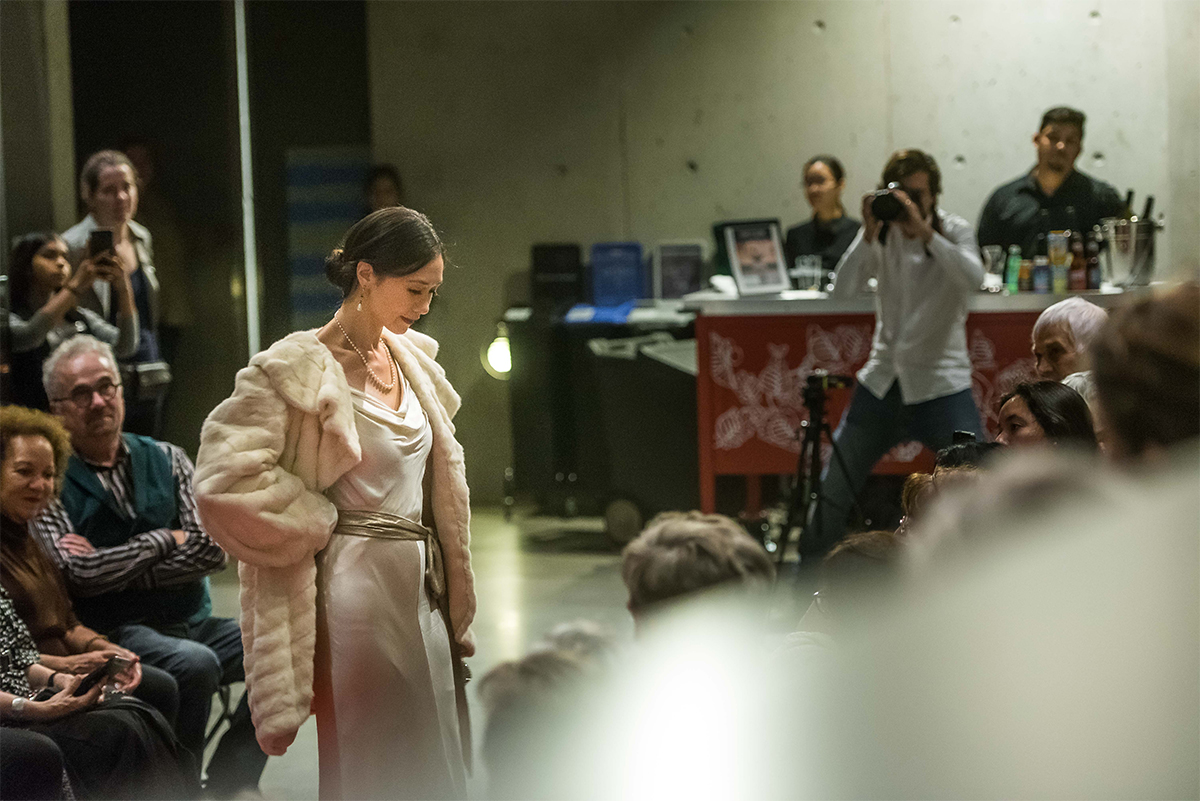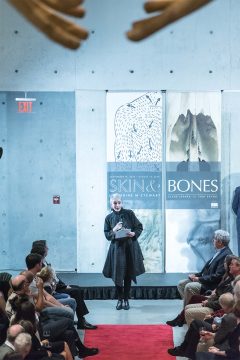On September 21st, 2018, I went to a fashion show with a twist: all of the outfits were once living things, from monkeys to bears to armadillos.
The fashion show, Beastly Habits, featured clothing from the collections of Claus Jahnke & Ivan Sayers. Highlights from this part of the evening include: an armadillo bag, a fashionable white fox draped on the arm, a leopard jacket, and various monkey fur items. All items had a story behind them, and most had a strong connection to BC. This presentation allowed the audience to reflect on the use of animals in fashion and how much attitudes toward their use have shifted in the past several decades.
This event was the kickoff for an exhibit that will live at the UBC Beaty Biodiversity Museum for the next year, and features photography that merges the human and the animal. The exhibit – Skin & Bones – also features accessories from the clothing collections of Claus Jahnke and Ivan Sayers. Catherine Stewart, the artist behind Skin and Bones, was inspired by the specimens she used to photograph from the UBC natural history collections more than 10 years ago, before the collections were moved into the Beaty Museum.

This work inspired her to reflect on how much humans have in common with the non-human inhabitants of the planet. The fascinating and hauntingly beautiful specimens themselves provided the inspiration to keep exploring connections as well as differences between our species and others.

Catherine Stewart, Artist
I got a chance to chat with Catherine before the fashion show, and asked her about her art and the exhibit.
Q. What feelings are you trying to evoke with the specimens and accessories you chose?
Catherine: Skin & Bones highlights the connection between human experience and the animal world. My hope is that this exhibit ‘touches’ the animal within us and, however slightly, shifts our perception of nature and our relationship to it. Situating fashion items in display cases with actual specimens from the collection brings their existence as once-living-entities home to the viewer in a direct way.
I helped with the initial selection of items from Claus’s and Ivan’s collections, but the Beaty Museum exhibits team developed the displays for the four cases of fashion accessories while I focused on the light boxes. For these, I chose specimens that interested me and that I thought would photograph well. Skulls, teeth, feet and claws were often chosen for my photographic compositions because of their clear relationship to the human form.
Q. Why do you think it’s important to show intersections between the world of science and the world of art? How does one inform the other?
Catherine: In this exhibition, I think the artwork and the fashion items provide a ‘portal’ or ‘lens’ through which the viewer can think about the animal world and related environmental issues. An art exhibition in a natural history museum can work as an entry point for all viewers to appreciate the aesthetics that transcend both art and science.
Q. How does this exhibit differ from your previous exhibit with this museum in 2013?
Catherine: While looking through the colourful songbird collection, I couldn’t help musing about the parallels in human and animal behaviour – especially with respect to visual display as a mechanism for attracting a mate. Nowhere is this more evident than in the world of fashion. This became the link to Ivan Sayers and Claus Jahnke and their amazing clothing collections that resulted in the Invoking Venus: Feathers and Fashion exhibit and fashion show in 2013. The exhibit was composed of my enlarged scanned images of bird plumage and vintage garments shown alongside display cases of historical fashion accessories made from feathers.
When thinking about the possibilities for a Skin & Bones exhibition, it occurred to me that I could team up with Claus and Ivan again – this time including a broader range of animals. I knew there would be a good number of animal-based fashion items to choose from in their collections for the display cases and fashion show. For my new photographic works – instead of clothing standing in for the human element, I decided to use images of the human form itself interacting or intersecting with the images of animal specimens. In contrast to the scanned enlargements of the Invoking Venus works, these much smaller images are predominantly lens-based compositions displayed in light box windows.
Claus Jahnke, Catherine Stewart, and Ivan Sayers
Q. What kind of attitudes have you noticed in recent years towards the use of animals for fashion and art, and have you noticed a change over time?
Catherine: Since the 1960’s there has been a gradual shift away from the use of ivory, furs and exotic skins in the fashion and art world. I think the shift is, to a large degree, the result of a growing awareness of the devastating impact the harvesting of animal parts on the viability of certain species, pushing some to near extinction. The killing of elephants for ivory tusks is particularly appalling. But is all fur trade wrong? Animal rights groups have effectively worked hard to convince us of this. But could fur trade of non-threatened species be carried out in a humane and sustainable way? If so, should this be judged to be any worse than the slaughter of domestic animals for fashion? Considering the living conditions of many factory-farmed animals, perhaps it could be argued that the hunt for animals in the wild is actually more ethical. And there are other economic and cultural considerations. A recent NFB film co-production with a group of young Inuit titled Angry Inuk reveals the negative impact of the EU international ban on seal fur trade for the Inuit people. This film certainly opened my eyes. Clearly, the arguments for and against the use of animals, both domestic and wild, for fashion are multi-layered and complex. The debate continues.
 Q. How do you see the difference between the use of animals for science and the use of animals for fashion/art?
Q. How do you see the difference between the use of animals for science and the use of animals for fashion/art?
Catherine: For science? This is a difficult question. I don’t pretend to be an expert in bio-ethics or to know the answer. Obviously, no threatened species should be used for such purposes. Beyond that, perhaps the basic requirement on which I think most of us would agree is that any scientific use be permitted only when there is a clear benefit to society and that it is conducted with humane treatment of animals. This guideline still puts human value above all other species – a problem for some animal rights proponents.
For fashion? Again, the arguments for and against the use of animals for fashion are complex. Should the same guidelines be applied for fashion as for science? After seeing the film Angry Inuk, I am not so sure. It seems there are no easy answers. Personally, I wouldn’t mind doing without an exotic looking alligator purse – especially one likely made from a creature that has been forced to live its entire life in a cement pool. However, I might have difficulty giving up buying leather shoes. I think this kind of question is something we should all take the time to consider.